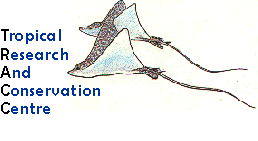|
Pulau
Sipadan and Pulau Mabul, Sabah
| Pulau
Sipadan is an internationally renowned SCUBA diving destination where sea turtles, coconut crabs,
sea snakes, and hammerhead sharks are the primary attractions. Dive operators at Sipadan have effectively banned blast and cyanide fishermen from the reefs, as the vigilance and presence of the operators on the islands has dissuaded villagers from nearby Mabul to encroach on the recovering reefs. This was not always the case: as recently as 1982, blast fishing on Sipadan was commonplace. Today, very little - if any - blastfishing occurs on
Sipadan, although blasts can still be heard. Most of these probably originate primarily from reefs around Mabul and
Kapalai. |
|
|
|
In
addition, conscientious dive operators on Sipadan and Mabul have strict 'no-touching' policies
among the divers, and their presence on the island deters artisanal and destructive fishers. Sipadan is also a special security area, being the cause of an international dispute between Indonesia and Malaysia, both of which claim ownership to the island, and for this reason is frequented more regularly by the Malaysian Navy and
marine police. This 'informal' protection system, along with the frequent visits by enforcement personnel, has brought about the recovery of the once-bombed reefs, which now thrive. In contrast, the reefs off Pulau
Tiga, on the Western coast of Sabah and which lack such a deterrent, have been virtually completely destroyed by blast fishermen. Similarly, several sites on the protected reefs of Tunku Abdul Rahman Park, off Kota
Kinabalu, Sabah, have also been badly destroyed in the absence of effective law enforcement. |
| Pulau
Layang Layang, Sabah
Pulau Layang Layang is one of the Spratly islands and reefs claimed by Malaysia. At Layang
Layang, the resort also enforces strict rules against touching the reef or harassing the wildlife, and restricts
offenders from diving. The remoteness of the reef and the presence of a military base dissuades blast and cyanide fishermen, although fishing boats of this type can sometimes be found seeking shelter in the lagoon during the monsoon season.
|
|
|
|
Pulau
Lankayan, Sabah
Lankayan, off the East coast of
Sabah, is a new SCUBA diving destination boasting a wide array of marine life, in particular giant clams, crinoids and a diverse benthic fauna. Here, only the resort operator accords protection. On
Mantanai, the resort owner has negotiated a 3 km no blasting zone with the police, community leaders and the blast fishers.
|
|
|
Parts
of East Kalimantan
In East
Kalimantan, Derawan, Sangalaki, Kakaban and Meratua are the primary SCUBA diving destinations. Both Derawan and Sangalaki support significant marine turtle nesting . Sangalaki is home to a resident population of manta rays, which form the backbone of the diving attraction. Kakaban contains an inland salt water lake renowned for its non-stinging jelly fish, while Meratua has steep drop-offs at which hammerhead sharks are commonly observed. Villagers on the islands collect and sell turtle eggs, and engage in destructive fishing techniques that have not yet been curbed either by the presence of two dive resorts (one each on Derawan and
Sangalaki) or by the fact that Sangalaki is a national park.
|
Coral
reefs within national parks in Sabah are open for fishing and have been
subjected to the same destructive fishing techniques as non-protected
reefs.
| BUT THERE
IS HOPE...
A
series of management guidelines were prepared for the Semporna Islands
Park (by Marine Conservation Society) which are nonetheless applicable to
other areas, whether they are already gazzetted as protected areas or
unregulated. Possibly, above all, the inclusion of local people in the
development of protected areas will prove the most productive of decisions
by local governments.
In the Tunku Abdul Rahman Park for instance, where
blast fishing continues in spite of being a protected area, the inclusion
of the local people in decision-making and in the overall development of
the Park would probably reduce unsustainable fishing significantly. The
employment of local villagers from Mabul by the Sipadan Mabul Resort
(SMART) provides sufficient feedback to the local community to stop blast
fishing at the sites commonly visited by tourists. |
|


![]()